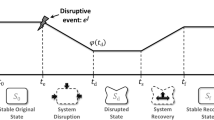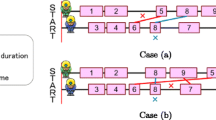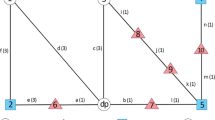Abstract
Disasters may cause significant damages and long-lasting failures in lifeline infrastructure networks (such as gas, power and water), which must be recovered quickly to resume providing essential services to the affected communities. While making repair plans, it is important to consider the interdependencies among network components to minimize recovery times. In this paper, we focus on post-disaster repair operations of multiple interdependent lifeline networks, which involve functional dependencies. We assume that each network component, whether damaged or not, becomes nonfunctional if it depends on another nonfunctional component, and it is recovered when all components that it depends on become functional. We introduce a post-disaster coordinated infrastructure repair routing problem, in which dedicated repair teams of each lifeline infrastructure travel through a road network to visit the sites with damaged network components. We present a mixed integer programming model that assigns repair teams to the sites and constructs routes for each team in order to minimize the sum of the recovery times for all network components. We develop a constructive heuristic and a simulated annealing algorithm to solve the proposed coordinated routing problem. We test the performance of the proposed solution algorithms on a set of instances that are developed based on two interdependent lifeline networks (e.g., power and gas). The computational results show that our heuristics can quickly find high-quality solutions. Our results also indicate that coordinating repair operations can significantly improve the overall recovery time of interdependent infrastructure networks.



Similar content being viewed by others
References
Afifi, S., Dang, D., & Moukrim, A. (2016). Heuristic solutions for the vehicle routing problem with time windows and synchronized visits. Optimization Letters, 10(3), 511–525.
Almoghathawi, Y., & Barker, K. (2019). Component importance measures for interdependent infrastructure network resilience. Computers & Industrial Engineering, 133, 153–164.
Almoghathawi, Y., Barker, K., & Albert, L. A. (2019). Resilience-driven restoration model for interdependent infrastructure networks. Reliability Engineering & System Safety, 185, 12–23.
Applied Technology Council. (2016). Critical assessment of lifeline system performance: Understanding societal needs in disaster recovery. National Institute of Standards and Technology.
Bagheri, A., Darijani, M., Asgary, A., & Morid, S. (2010). Crisis in urban water systems during the reconstruction period: A system dynamics analysis of alternative policies after the 2003 earthquake in Bam-Iran. Water Resources Management, 24(11), 2567–2596.
Barker, K., Lambert, J. H., Zobel, C. W., Tapia, A. H., Ramirez-Marquez, J. E., Albert, L., et al. (2017). Defining resilience analytics for interdependent cyber–physical–social networks. Sustainable and Resilient Infrastructure, 2(2), 59–67.
Bigger, J. E., Willingham, M. G., Krimgold, F., Mili, L., et al. (2009). Consequences of critical infrastructure interdependencies: Lessons from the 2004 hurricane season in Florida. International Journal of Critical Infrastructures, 5(3), 199.
Brown, C., Milke, M., & Seville, E. (2010). Waste management as a lifeline? A New Zealand case study analysis. International Journal of Disaster Resilience in the Built Environment, 1, 192–206.
Campbell, A. M., Vandenbussche, D., & Hermann, W. (2008). Routing for relief efforts. Transportation Science, 42(2), 127–145.
Caunhye, A. M., Aydin, N. Y., & Duzgun, H. S. (2020). Robust post-disaster route restoration. OR Spectrum, 42(4), 1055–1087.
Çavdaroglu, B., Hammel, E., Mitchell, J. E., Sharkey, T. C., & Wallace, W. A. (2013). Integrating restoration and scheduling decisions for disrupted interdependent infrastructure systems. Annals of Operations Research, 203(1), 279–294.
Çelik, M. (2016). Network restoration and recovery in humanitarian operations: Framework, literature review, and research directions. Surveys in Operations Research and Management Science, 21(2), 47–61.
Coco, A. A., Duhamel, C., & Santos, A. C. (2020). Modeling and solving the multi-period disruptions scheduling problem on urban networks. Annals of Operations Research, 285(1–2), 427–443.
Coffrin, C., Van Hentenryck, P., & Bent, R. (2012). Last-mile restoration for multiple interdependent infrastructures. In Twenty-sixth AAAI conference on artificial intelligence (pp. 455–463).
Drexl, M. (2012). Synchronization in vehicle routing—A survey of VRPs with multiple synchronization constraints. Transportation Science, 46(3), 297–316.
Dubey, R., Bryde, D. J., Foropon, C., Graham, G., Giannakis, M., & Mishra, D. B. (2020). Agility in humanitarian supply chain: An organizational information processing perspective and relational view. Annals of Operations Research, 1–21.
González, A. D., Dueñas-Osorio, L., Sánchez-Silva, M., & Medaglia, A. L. (2016). The interdependent network design problem for optimal infrastructure system restoration. Computer-Aided Civil and Infrastructure Engineering, 31(5), 334–350.
Griffith, D. A., Boehmke, B., Bradley, R. V., Hazen, B. T., & Johnson, A. W. (2019). Embedded analytics: Improving decision support for humanitarian logistics operations. Annals of Operations Research, 283(1–2), 247–265.
Hallegatte, S., Rentschler, J., & Rozenberg, J. (2019). LIFELINES: The resilient infrastructure opportunity. Sustainable infrastructure series. Washington, DC: The World Bank.
Huang, M., Smilowitz, K., & Balcik, B. (2012). Models for relief routing: Equity, efficiency and efficacy. Transportation Research Part E: Logistics and Transportation Review, 48(1), 2–18.
Iloglu, S., & Albert, L. A. (2018). An integrated network design and scheduling problem for network recovery and emergency response. Operations Research Perspectives, 5, 218–231.
Karagiannis, G. M., Chondrogiannis, S. Krausmann, E., & Turksezer, Z. I. (2017). Power grid recovery after natural hazard impact. Joint Research Center: European Union. Retrieved November 14, 2020, from https://publications.jrc.ec.europa.eu/repository/bitstream/JRC108842/jrc108842kjna28844enn.pdf.
Kattel, P. J., & Aros-Vera, F. (2020). Critical infrastructure location under supporting station dependencies considerations. Socio-Economic Planning Sciences, 70, 100726.
Kirkpatrick, S., Gelatt, C. D., & Vecchi, M. P. (1983). Optimization by simulated annealing. Science, 220(4598), 671–680.
Lee, E. E., Mitchell, J. E., & Wallace, W. A. (2007). Restoration of services in interdependent infrastructure systems: A network flows approach. IEEE Transactions on Systems, Man, and Cybernetics, Part C (Applications and Reviews), 37(6), 1303–1317.
Li, S., Ma, Z., & Teo, K. L. (2020). A new model for road network repair after natural disasters: Integrating logistics support scheduling with repair crew scheduling and routing activities. Computers & Industrial Engineering, 145, 106506.
Li, S., & Teo, K. L. (2019). Post-disaster multi-period road network repair: Work scheduling and relief logistics optimization. Annals of Operations Research, 283(1–2), 1345–1385.
Li, Y., Lim, A., & Rodrigues, B. (2005). Manpower allocation with time windows and job-teaming constraints. Naval Research Logistics, 52(4), 302–311.
Lu, B., & Shahidehpour, M. (2004). Short-term scheduling of combined cycle units. IEEE Transactions on Power Systems, 19(3), 1616–1625.
Metropolis, N., Rosenbluth, A. W., Rosenbluth, M. N., Teller, A. H., & Teller, E. (1953). Equation of state calculations by fast computing machines. Journal of Chemical Physics, 21(6), 1087–1092.
Mooney, E. L., Almoghathawi, Y., & Barker, K. (2018). Facility location for recovering systems of interdependent networks. IEEE Systems Journal, 13(1), 489–499.
Morshedlou, N., González, A. D., & Barker, K. (2018). Work crew routing problem for infrastructure network restoration. Transportation Research Part B: Methodological, 118, 66–89.
Ouyang, M. (2014). Review on modeling and simulation of interdependent critical infrastructure systems. Reliability Engineering & System Safety, 121, 43–60.
Pamukcu, D., & Balcik, B. (2020). A multi-cover routing problem for planning rapid needs assessment under different information-sharing settings. OR Spectrum, 42(1), 1–42.
Pressly, R. (2014). Improving lifelines: Protecting critical infrastructure for resilient counties. Technical report. Retrieved November 14, 2020, from https://www.naco.org/sites/default/files/documents/NACo_ResilientCounties_Lifelines_Nov2014.pdf.
Ransikarbum, K., & Mason, S. J. (2016). Goal programming-based post-disaster decision making for integrated relief distribution and early-stage network restoration. International Journal of Production Economics, 182, 324–341.
Rinaldi, S. M., Peerenboom, J. P., & Kelly, T. K. (2001). Identifying, understanding, and analyzing critical infrastructure interdependencies. IEEE Control Systems, 21(6), 11–25.
Ropke, S., & Pisinger, D. (2006). An adaptive large neighborhood search heuristic for the pickup and delivery problem with time windows. Transportation Science, 40(4), 455–472.
Sharkey, T. C., Çavdaroglu, B., Nguyen, H., Holman, J., Mitchell, J. E., & Wallace, W. A. (2015). Interdependent network restoration: On the value of information-sharing. European Journal of Operational Research, 244(1), 309–321.
Solomon, M. M. (1987). Algorithms for the vehicle routing and scheduling problems with time window constraints. Operations Research, 35(2), 254–265.
Wei, L., Zhang, Z., Zhang, D., & Leung, S. C. H. (2018). A simulated annealing algorithm for the capacitated vehicle routing problem with two-dimensional loading constraints. European Journal of Operational Research, 265(3), 843–859.
Zhang, P., & Peeta, S. (2011). A generalized modeling framework to analyze interdependencies among infrastructure systems. Transportation Research Part B: Methodological, 45(3), 553–579.
Zimmerman, R. (2001). Social implications of infrastructure network interactions. Journal of Urban Technology, 8(3), 97–119.
Author information
Authors and Affiliations
Corresponding author
Additional information
Publisher's Note
Springer Nature remains neutral with regard to jurisdictional claims in published maps and institutional affiliations.
Appendices
Appendix A: Interdependency parameters
We provide the interdependency parameters for the illustrative example presented in Sect. 3.1.4 below (Table 11).
Appendix B: The instance generator
We briefly introduce our Instance Generator, which is a dashboard developed by using R programming language. This dashboard allows us to generate IIRRP test instances that involve two interdependent infrastructure networks systematically. The source code for the dashboard in R is available upon request from the researchers.
The dashboard, which is shown in Fig. 4, generates the input files for the IIRRP model and the SA heuristic. Additionally, it visualizes the generated infrastructure network as in Fig. 2a). The dashboard accepts a single input file (network_input.txt in the figure), which lists the coordinates of the depots and sites involving the infrastructure nodes in the network. All other parameter levels are set through the dashboard. Based on the selected parameter levels, the input data are automatically generated as described in Sect. 5.1.
Appendix C: Results: effects of cooling parameter
In our computational experiments, we use a geometric cooling schedule and present results obtained with \(\alpha =0.90\). We test the performance of the proposed \(SA_2\) algorithm by using alternative cooling parameters. Here we present results obtained by \(\alpha =0.85\) and \(\alpha =0.95\). Table 12 shows the percentage gap between solutions obtained by \(SA_2\) and CPLEX for 16 small instances (i.e., Set 1 instances), similar to Table 5.
For \(\alpha =0.90\), it takes \(SA_2\) 1,179 CPU seconds on average to solve these instances, which decreases to 739 when \(\alpha =0.85\). However, we observe that solution performance worsens when we cool the temperature at a faster rate. For example, when \(\alpha \) is reduced to 0.85, the average gap percentage with respect to CPLEX increases to 0.16% from 0.07%; furthermore, average \(n_{best}\) decreases from 5.9 to 4.3. On the contrary, we observe that the performance is improved when \(\alpha =0.95\); for example, average gap decreases to \(-0.01\). However, we observe a significant increase in average CPU time (i.e., about 70%) when algorithm is cooled slower. These results show the trade-off between the solution quality and time. Decision makers can choose a proper cooling rate depending on the urgency of planning on the ground. In our experiments, we use \(\alpha =0.90\) that balances solution quality and time.
Rights and permissions
About this article
Cite this article
Atsiz, E., Balcik, B., Gunnec, D. et al. A coordinated repair routing problem for post-disaster recovery of interdependent infrastructure networks. Ann Oper Res 319, 41–71 (2022). https://doi.org/10.1007/s10479-020-03909-w
Accepted:
Published:
Issue Date:
DOI: https://doi.org/10.1007/s10479-020-03909-w





